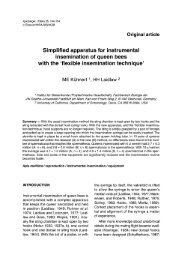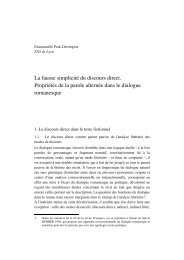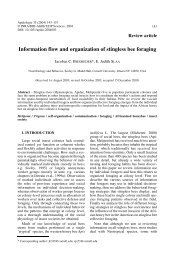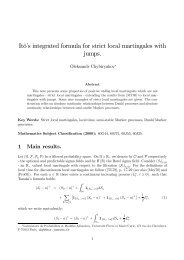ARBEITSGEMEINSCHAFT DER INSTITUTE FÜR ... - HAL - INRIA
ARBEITSGEMEINSCHAFT DER INSTITUTE FÜR ... - HAL - INRIA
ARBEITSGEMEINSCHAFT DER INSTITUTE FÜR ... - HAL - INRIA
You also want an ePaper? Increase the reach of your titles
YUMPU automatically turns print PDFs into web optimized ePapers that Google loves.
diluted<br />
(0,01-10,0 mg/ml) an Larven vom 1. Stadium an verfüttert (Fraßgift-Test) oder<br />
in Aceton gelöst topikal auf Larven des 3. Stadiums (L3) aufgeträufelt (0-0,5 IL g/<br />
L3) (Kontaktgift-Test). Steigende Dosen des Insektizids bewirkten Störungen in<br />
der Larvenentwicklung, Hemmung der Larven-Larven- und Larven-Puppen-<br />
Häutung sowie Absterben der Vorpuppen. Die halbletale Konzentration (LC 5v )<br />
des Insektizids lag nach oraler Anwendung bei 0,18 IL g/Larve (22,5 Eag/g). Nach<br />
topikaler Behandlung der Larven mit Parathion betrug die halbletale Dosis (LD;,o)<br />
ebenfalls 0,18 pg/Larve. Beide Werte liegen im selben Konzentrationsbereich<br />
wie er bei Adulten gefunden wurde. Zur Ermittlung der Giftigkeit von Pflanzenschutzmitteln<br />
an Bienenlarven kann die Situation in einem Brutnest einfach mit<br />
Vorteil dieser Methode<br />
Hilfe dieses in vitro Tests simuliert werden. Ein spezieller<br />
ist, daß eine unkontrollierte Beeinflussung der Brut durch die Ammenbienen<br />
ausgeschlossen wird. Die Brut kann in jedem Stadium beobachtet werden ohne<br />
den Entwicklungsablauf zu stören. Der standardisierte Aufzuchtstest ist daher<br />
besonders gut geeignet, eine mögliche larvizide Wirkung konventioneller und unkonventioneller<br />
Pflanzenschutzmittel direkt an Bienenlarven zu prüfen.<br />
SUMMARY<br />
Effect of parathion on honey bee larvae reared in vitro<br />
First instar honey bee larvae (body weight 0.2-0.4 mg) from outdoor colonies<br />
were reared in an incubator on a semi-synthetic diet under standardized<br />
conditions (1). Parathion was either dissolved in the diet (0.01-10.0 p.g/ml)<br />
-<br />
(stomach poison test) or in acetone and topically applied (0-0.5 pg/3rd<br />
instar larva) (contact poison test). Increasing doses of parathion caused delay<br />
in larval development, inhibition of larval-larval and larval-pupal molts and<br />
prepupal mortality. The half lethal concentration (Lc zo ) of the insecticide after<br />
oral administration and continuous feeding, respectively, was 0.18 pg/larva<br />
(22.5 yg/g body weight). After topical application the half lethal dose (LD 50 )<br />
was also 0.18 jLg/larva. Both amounts were at the same level which was<br />
found in adults. For evaluation of pesticide toxicity to honey bee larvae, the<br />
situation in a brood nest can easily be simulated by this in vitro test. A special<br />
advantage of this method is that uncontrolled interference with the brood by<br />
the nurse bees is excluded, and that the brood can be observed at each stage of<br />
development. The standardized rearing method for bee larvae is therefore very<br />
convenient for the testing of possible larvicidal effects of conventional and unconventional<br />
plant protection chemical.




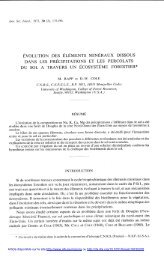
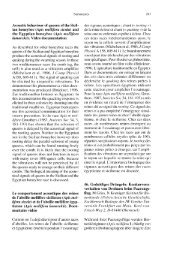
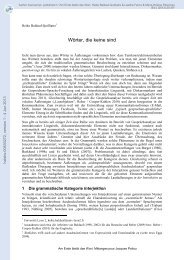
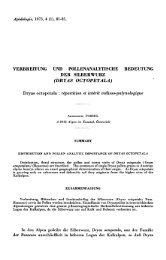
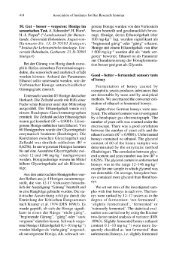
![4 C]-Polyethylenglykol bestimmt, der - HAL - INRIA](https://img.yumpu.com/22454280/1/177x260/4-c-polyethylenglykol-bestimmt-der-hal-inria.jpg?quality=85)
